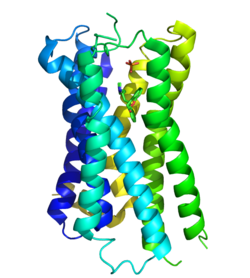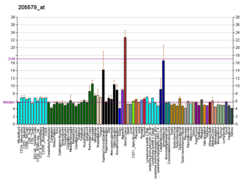| HRH1 |
|---|
 |
| Cấu trúc được biết đến |
|---|
| PDB | Tìm trên Human UniProt: PDBe RCSB |
|---|
|
|
| Mã định danh |
|---|
| Danh pháp | HRH1, H1-R, H1R, HH1R, hisH1, histamine receptor H1 |
|---|
| ID ngoài | OMIM: 600167 HomoloGene: 668 GeneCards: HRH1 |
|---|
|
| Bản thể gen |
|---|
| Chức năng phân tử | • histamine receptor activity
• signal transducer activity
• G protein-coupled receptor activity
• G protein-coupled serotonin receptor activity
• neurotransmitter receptor activity
|
|---|
| Thành phần tế bào | • integral component of membrane
• membrane
• integral component of plasma membrane
• Màng tế bào
• cytosol
• sợi nhánh
|
|---|
| Quá trình sinh học | • eosinophil chemotaxis
• inositol phosphate-mediated signaling
• regulation of vasoconstriction
• positive regulation of inositol trisphosphate biosynthetic process
• cellular response to histamine
• regulation of vascular permeability
• phospholipase C-activating G protein-coupled receptor signaling pathway
• regulation of synaptic plasticity
• G protein-coupled receptor signaling pathway
• modulation of chemical synaptic transmission
• inflammatory response
• visual learning
• GO:0072468 signal transduction
• trí nhớ
• positive regulation of vasoconstriction
• G protein-coupled receptor signaling pathway, coupled to cyclic nucleotide second messenger
• chemical synaptic transmission
• G protein-coupled serotonin receptor signaling pathway
|
|---|
| Nguồn: Amigo / QuickGO |
|
| Gen cùng nguồn |
|---|
| Loài | Người | Chuột |
|---|
| Entrez | | |
|---|
| Ensembl | | |
|---|
| UniProt | | |
|---|
| RefSeq (mRNA) | |
|---|
NM_000861
NM_001098211
NM_001098212
NM_001098213 |
| |
|---|
| RefSeq (protein) | |
|---|
NP_000852
NP_001091681
NP_001091682
NP_001091683 |
| |
|---|
| Vị trí gen (UCSC) | n/a | n/a |
|---|
| PubMed | [1] | n/a |
|---|
| Wikidata |
|
Thụ thể H1 là thụ thể histamine thuộc họ thụ thể bắt cặp với protein G giống rhodopsin. Thụ thể này được kích hoạt bởi histamine. Nó được biểu hiện ở các cơ trơn, các tế bào nội mô mạch máu, tim và hệ thần kinh trung ương. Thụ thể H1 liên kết với protein G nội bào (Gq) để kích hoạt phospholipase C và con đường truyền tín hiệu inositol triphosphate (IP3). Thuốc kháng histamine, hoạt động trên thụ thể này, được dùng làm thuốc chống dị ứng. Cấu trúc tinh thể của thụ thể đã được xác định (hình bên phải) [2] và được sử dụng để khám phá các phối tử mới của thụ thể histamine H1 trong các nghiên cứu sàng lọc ảo dựa trên cấu trúc.[3]
Vai trò trong viêm
Sự biểu hiện của NF-κB, yếu tố phiên mã điều hòa các quá trình viêm, được tăng cường bởi hoạt động cấu thành của thụ thể H1 cũng như bởi các chất chủ vận liên kết với thụ thể. Thuốc kháng histamine H1 đã được chứng minh là làm giảm biểu hiện NF-κB và giảm thiểu các quá trình viêm nhất định.
Sinh lý thần kinh
Các thụ thể histamine H1 được kích hoạt bởi histamine nội sinh, được giải phóng bởi các tế bào thần kinh có thân tế bào trong nhân củ vú của vùng dưới đồi. Các tế bào thần kinh histaminergic của nhân củ vú hoạt động trong chu kỳ 'thức' với tần số khoảng 2 Hz; trong giấc ngủ sóng chậm (ngủ sâu), tần số giảm xuống khoảng 0,5 Hz. Cuối cùng, trong giấc ngủ REM, các tế bào thần kinh histaminergic ngừng hoạt động hoàn toàn. Trong khi thức, các tế bào thần kinh histaminergic có nhiều tần số nhất trong tất cả các loại tế bào thần kinh.[4]
Nhân củ vú là một nhân histaminergic có khả năng điều hòa tốt chu kỳ ngủ - thức.[5] Những chất kháng histamine-H1 khi vượt qua hàng rào máu não sẽ gây ức chế hoạt động của thụ thể H1 trên các tế bào thần kinh thuộc nhân củ vú. Đó là lý do tại sao dùng mấy loại thuốc này sẽ gây ra sự buồn ngủ.
Xem thêm
Tham khảo
- ^ “Human PubMed Reference:”.
- ^ Shimamura T, Shiroishi M, Weyand S, Tsujimoto H, Winter G, Katritch V, Abagyan R, Cherezov V, Liu W, Han GW, Kobayashi T, Stevens RC, Iwata S (tháng 7 năm 2011). “Structure of the human histamine H1 receptor complex with doxepin”. Nature. 475 (7354): 65–70. doi:10.1038/nature10236. PMC 3131495. PMID 21697825.
- ^ de Graaf C, Kooistra AJ, Vischer HF, Katritch V, Kuijer M, Shiroishi M, Iwata S, Shimamura T, Stevens RC, de Esch IJ, Leurs R (tháng 12 năm 2011). “Crystal structure-based virtual screening for fragment-like ligands of the human histamine H(1) receptor”. Journal of Medicinal Chemistry. 54 (23): 8195–206. doi:10.1021/jm2011589. PMC 3228891. PMID 22007643.
- ^ Passani MB, Lin JS, Hancock A, Crochet S, Blandina P (tháng 12 năm 2004). “The histamine H3 receptor as a novel therapeutic target for cognitive and sleep disorders”. Trends in Pharmacological Sciences. 25 (12): 618–25. doi:10.1016/j.tips.2004.10.003. PMID 15530639.
- ^ Malenka RC, Nestler EJ, Hyman SE (2009). “Chapter 6: Widely Projecting Systems: Monoamines, Acetylcholine, and Orexin”. Trong Sydor A, Brown RY (biên tập). Molecular Neuropharmacology: A Foundation for Clinical Neuroscience (ấn bản 2). New York: McGraw-Hill Medical. tr. 175–176. ISBN 9780071481274.
Within the brain, histamine is synthesized exclusively by neurons with their cell bodies in the tuberomammillary nucleus (TMN) that lies within the posterior hypothalamus. There are approximately 64000 histaminergic neurons per side in humans. These cells project throughout the brain and spinal cord. Areas that receive especially dense projections include the cerebral cortex, hippocampus, neostriatum, nucleus accumbens, amygdala, and hypothalamus. ... While the best characterized function of the histamine system in the brain is regulation of sleep and arousal, histamine is also involved in learning and memory ... It also appears that histamine is involved in the regulation of feeding and energy balance.
Đọc thêm
- Mitsuchashi M, Payan DG (tháng 6 năm 1989). “Molecular and cellular analysis of histamine H1 receptors on cultured smooth muscle cells”. Journal of Cellular Biochemistry. 40 (2): 183–92. doi:10.1002/jcb.240400207. PMID 2670975. S2CID 43161416.
- Braman SS (1987). “Histamine receptors in the lung”. New England and Regional Allergy Proceedings. 8 (2): 116–20. doi:10.2500/108854187778994446. PMID 2886904.
- Hill SJ, Ganellin CR, Timmerman H, Schwartz JC, Shankley NP, Young JM, Schunack W, Levi R, Haas HL (tháng 9 năm 1997). “International Union of Pharmacology. XIII. Classification of histamine receptors”. Pharmacological Reviews. 49 (3): 253–78. PMID 9311023.
- Holden CA, Chan SC, Norris S, Hanifin JM (tháng 10 năm 1987). “Histamine induced elevation of cyclic AMP phosphodiesterase activity in human monocytes”. Agents and Actions. 22 (1–2): 36–42. doi:10.1007/BF01968814. PMID 2891264. S2CID 23962587.
- Moguilevsky N, Varsalona F, Noyer M, Gillard M, Guillaume JP, Garcia L, Szpirer C, Szpirer J, Bollen A (tháng 9 năm 1994). “Stable expression of human H1-histamine-receptor cDNA in Chinese hamster ovary cells. Pharmacological characterisation of the protein, tissue distribution of messenger RNA and chromosomal localisation of the gene”. European Journal of Biochemistry / FEBS. 224 (2): 489–95. doi:10.1111/j.1432-1033.1994.00489.x. PMID 7925364.
- Fukui H, Fujimoto K, Mizuguchi H, Sakamoto K, Horio Y, Takai S, Yamada K, Ito S (tháng 6 năm 1994). “Molecular cloning of the human histamine H1 receptor gene”. Biochemical and Biophysical Research Communications. 201 (2): 894–901. doi:10.1006/bbrc.1994.1786. PMID 8003029.
- Le Coniat M, Traiffort E, Ruat M, Arrang JM, Berger R (tháng 8 năm 1994). “Chromosomal localization of the human histamine H1-receptor gene”. Human Genetics. 94 (2): 186–8. doi:10.1007/bf00202867. PMID 8045566. S2CID 13583779.
- De Backer MD, Gommeren W, Moereels H, Nobels G, Van Gompel P, Leysen JE, Luyten WH (tháng 12 năm 1993). “Genomic cloning, heterologous expression and pharmacological characterization of a human histamine H1 receptor”. Biochemical and Biophysical Research Communications. 197 (3): 1601–8. doi:10.1006/bbrc.1993.2662. PMID 8280179.
- Hishinuma S, Young JM (tháng 11 năm 1995). “Characteristics of the binding of [3H]-mepyramine to intact human U373 MG astrocytoma cells: evidence for histamine-induced H1-receptor internalisation”. British Journal of Pharmacology. 116 (6): 2715–23. doi:10.1111/j.1476-5381.1995.tb17232.x. PMC 1909113. PMID 8590995.
- Max SI, Chowdhury BA, Fraser CM (tháng 6 năm 1996). “Sequence analysis of the 5'-untranslated region of the human H1 histamine receptor-encoding gene”. Gene. 171 (2): 309–10. doi:10.1016/0378-1119(96)00036-4. PMID 8666296.
- De Backer MD, Loonen I, Verhasselt P, Neefs JM, Luyten WH (tháng 11 năm 1998). “Structure of the human histamine H1 receptor gene”. The Biochemical Journal. 335 (3): 663–70. doi:10.1042/bj3350663. PMC 1219830. PMID 9794809.
- Horváth BV, Szalai C, Mándi Y, László V, Radvány Z, Darvas Z, Falus A (tháng 11 năm 1999). “Histamine and histamine-receptor antagonists modify gene expression and biosynthesis of interferon gamma in peripheral human blood mononuclear cells and in CD19-depleted cell subsets”. Immunology Letters. 70 (2): 95–9. doi:10.1016/S0165-2478(99)00126-1. PMID 10569698.
- Wang KY, Arima N, Higuchi S, Shimajiri S, Tanimoto A, Murata Y, Hamada T, Sasaguri Y (tháng 5 năm 2000). “Switch of histamine receptor expression from H2 to H1 during differentiation of monocytes into macrophages”. FEBS Letters. 473 (3): 345–8. doi:10.1016/S0014-5793(00)01560-X. PMID 10818238. S2CID 772640.
- Oda T, Morikawa N, Saito Y, Masuho Y, Matsumoto S (tháng 11 năm 2000). “Molecular cloning and characterization of a novel type of histamine receptor preferentially expressed in leukocytes”. The Journal of Biological Chemistry. 275 (47): 36781–6. doi:10.1074/jbc.M006480200. PMID 10973974.
- Brew OB, Sullivan MH (tháng 9 năm 2001). “Localisation of mRNAs for diamine oxidase and histamine receptors H1 and H2, at the feto-maternal interface of human pregnancy”. Inflammation Research. 50 (9): 449–52. doi:10.1007/PL00000269. PMID 11603849. S2CID 28710647.
- Gutzmer R, Langer K, Lisewski M, Mommert S, Rieckborn D, Kapp A, Werfel T (tháng 3 năm 2002). “Expression and function of histamine receptors 1 and 2 on human monocyte-derived dendritic cells”. The Journal of Allergy and Clinical Immunology. 109 (3): 524–31. doi:10.1067/mai.2002.121944. PMID 11898002.
- Idzko M, la Sala A, Ferrari D, Panther E, Herouy Y, Dichmann S, Mockenhaupt M, Di Virgilio F, Girolomoni G, Norgauer J (tháng 5 năm 2002). “Expression and function of histamine receptors in human monocyte-derived dendritic cells”. The Journal of Allergy and Clinical Immunology. 109 (5): 839–46. doi:10.1067/mai.2002.124044. PMID 11994709.
Liên kết ngoài
- “Histamine Receptors: H1”. IUPHAR Database of Receptors and Ion Channels. International Union of Basic and Clinical Pharmacology. Bản gốc lưu trữ ngày 3 tháng 3 năm 2016. Truy cập ngày 29 tháng 1 năm 2021.















